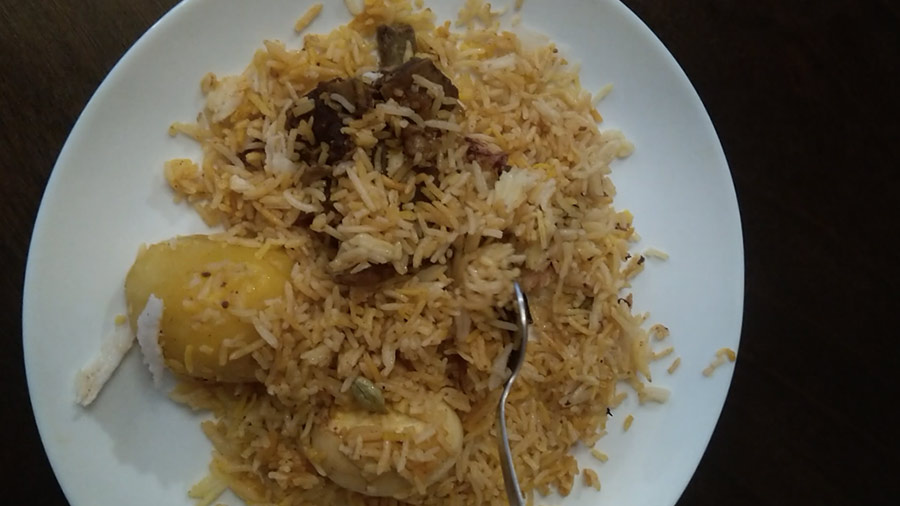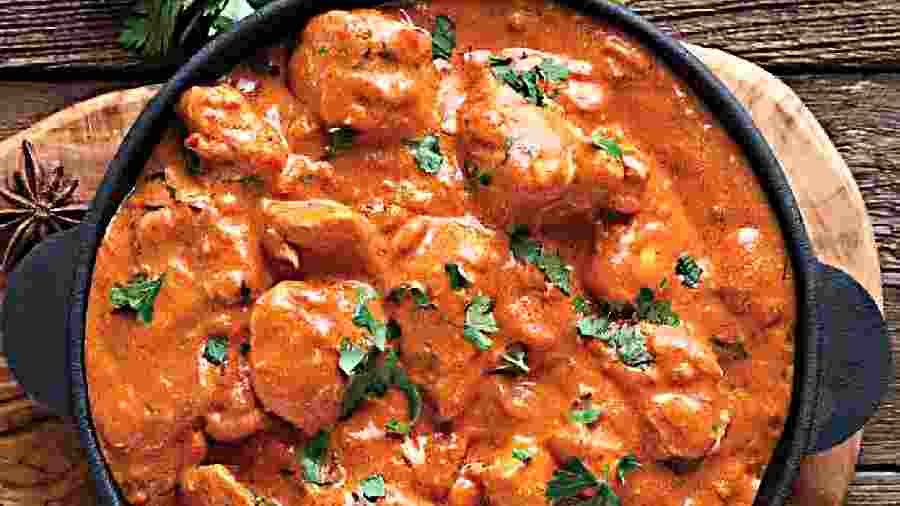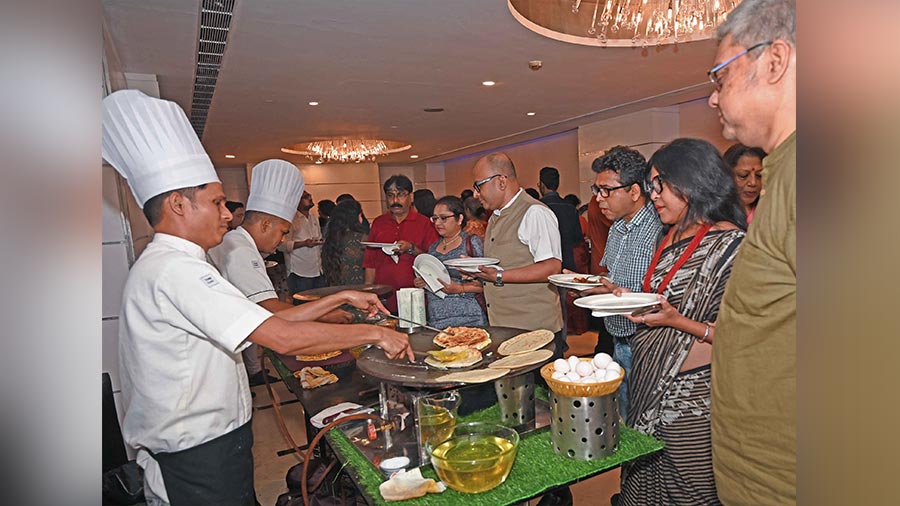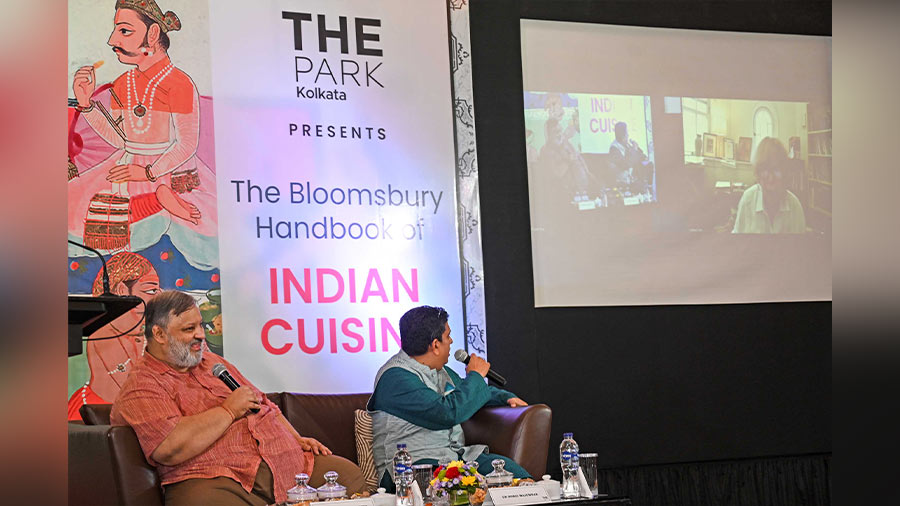From biryani to butter chicken, masala dosa to mishti — India’s dishes are a happy kaleidoscope of flavours that have baffled, amused, and delighted food connoisseurs across the world. The Bloomsbury Handbook of Indian Cuisine, edited by Colleen Taylor Sen, Sourish Bhattacharyya and Helen Saberi is a comprehensive reference work that delves into the rich and multifaceted world of Indian cuisine and culinary traditions. A food lover's compendium, it has alphabetically arranged entries that are a seamless blend of the factual and the historical.
At the recent launch of the book on August 29 held at The Park Kolkata, sports journalist and writer, Boria Majumdar was in conversation with Colleen Taylor Sen and Sourish Bhattacharyya discussing the process of writing the book, India’s street food, Kolkata’s biryani and a lot more.
The evening commenced with the felicitation of Majumdar and Bhattacharya by Pramod Bhandari, executive manager of The Park Kolkata, followed by the unveiling of the book.
A labour of love

Copies of the book at the event
Speaking about the process of writing, Colleen Taylor Sen, who joined the event on video call, revealed how the book took about three years to see the light of day.
“Sourish approached me about a book that would be like a comprehensive companion to Indian food. I mentioned that we already had a proposal in the works because we had been considering this earlier, and it ended up going to Bloomsbury. This turned out to be a good decision because now there are more talented food writers in India than before. Around 25 or 26 contributed, besides the three of us. That's how the project began. Of course, India is incredibly diverse, and for a book of this scope, we couldn't cover the entire country. To put it in perspective, a few years ago, some colleagues and I wrote a book solely about Chicago food. Similarly, you could have books like that for Delhi, Kolkata, and every region in India. So, this book offers an overview of what we considered to be the key aspects of Indian cuisine.
Initially, it was meant as an academic work for non-Indian audiences. However, Sourish managed to convince Bloomsbury India to publish it. In the US, it's still quite expensive due to its academic nature, but we're hopeful that a more affordable paperback edition will be released eventually. The process was quite challenging, involving a lot of administrative work, and it took nearly three years to complete,” she said.
‘You cannot paint India with one brush’

Sourish Bhattacharyya in conversation with Boria Majumdar
While a compendium on Indian cuisines seems comprehensive and formidable, it is almost impossible to fit India’s gastronomical practices into one particular mould. This was a sentiment that was echoed by Bhattacharya when asked if there was anything called an ‘Indian cuisine’.
“I think every home in India has its own cuisine. We had to give the book a structure and that’s why what we have done is that we have covered all the states and union territories of India and also some important food cities. Even while doing our research we found, for instance, that Arunachal Pradesh, has 21 tribes and each tribe has its distinctive cuisine. In Nagaland again there is nothing called a typical Naga cuisine. In Bengal as well, there is the Bangal-Ghoti antagonism about the type of food that is cooked. So you cannot paint India with one brush,” said Bhattacharya.
The baffling histories of biryani and butter chicken

While the ‘alu’ and egg are often considered blasphemous by a wide section of the country, a Kolkata biryani is incomplete without it
After politics, if there is one thing that can divide the country, it is biryani. While Kolkatans would sell their souls for that savoured piece of alu (potato) in the biryani, Hyderabadis would rather starve than feed themselves such a combination. But the history of the dish would tell a different story. Bhattacharyya pointed out that biryani has evolved from India’s long tradition of cooking meats and rice together.
“There are ancient Indian scriptures that mention cooking rice and meats together. So what I think happened over the years and what is mentioned in the Ain-i-Akbari as well, is that the tradition of rice and meat being cooked together got refined and acquired local flavours in each state. Therefore, each state has its own biriyani. Tamil Nadu has this Dindigul biriyani, then there is Arcot biryani alongside the Hyderabadi, Bengali, Lucknowi, and other biryanis,” he elaborated.
Even though the alu and egg in Kolkata biryani are considered blasphemous by a wide section of the country, the food journalist reassured the audience that the alu has always been there for “‘scientific” purposes. “Manish Mehrotra told me how advanced Bengalis are because the alu sucks up all the masalas in the Biryani and one can taste the Biryani in the alu. It is a scientific thing and is not simply there for special effects,” clarified Bhattacharyya.
Unlike the history of biryani, which has been well documented, the history of butter chicken has been shrouded in mystery. Fables abound about one of India’s most famous dishes. Thankfully, this conundrum has been addressed in the book as well.
When Majumdar enquired about the north Indian delicacy, Bhattacharyya remarked that “there are as many stories as there are people selling butter chicken”. Even though it is widely believed that it was invented by Kundan Lal Gujral, the founder of Moti Mahal in Punjab, there are no definitive answers that might satisfy fastidious foodies.

When it comes to butter chicken’s origins, there are no definitive answers that might satisfy fastidious foodies
“Santha Rama Rao’s The Cooking of India was one of the earliest definitive books on Indian books that talks about Moti Mahal. The author talks about naan and tandoori chicken and even includes a menu of Moti Mahal in the book but there is no mention of butter chicken. So butter chicken wasn’t invented in 1954 when Santha Rama Rao wrote the book. According to Kundan Lal Jaggi (partner and co-founder of Moti Mahal), during the evenings, they used to serve the aam janta (common people) which constituted Punjabi refugees and groups who could not afford a proper meal at the restaurant. One day, too many people turned up and the people of Moti Mahal realised that they had leftover tandoori chicken. To this, they added cream, tomatoes, onion, and whatever they could find to create the gravy. For the people of Moti Mahal it was a one-off thing, but somehow people loved that butter chicken and kept coming back to it. However, there is also a side story that there is a Pakistani gentleman who recently died in Glasgow and claimed to have created the butter chicken around 1971,” noted Bhattacharyya.
Serving it hot

The dinner after the event, at The Park Kolkata
Colleen Taylor Sen, who has researched and written extensively on South Asian cuisines, revealed how the secret to having a safe experience with the street food of India is all about having it “hot”.
“I love street food and I think Indian street food is one of the glories of Indian cuisine. For many people, it is like a meal and a very important form of employment. There are millions of people employed in the street food industry. To be safe, you’re supposed to eat street food when it's hot. I think that people are afraid of street food, especially foreigners, but it's crazy because when you see long lines in front of a street food stand you should know that it must be pretty good. Now I think there is a lot of emphasis on teaching street food vendors about hygiene. One of the things that I have noticed now in the US wedding receptions and parties is that there will always be a street food table and people would have stuff like gol gappas and other such popular street foods. They are becoming a part of everyday life now,” she added.
But no discussions about food in Kolkata can end without a discussion on mishti. Bhattacharyya briefly spoke about how the name ‘Ledikeni’ comes from the name of Lady Canning and Majumdar added how on the night that PV Sindhu won silver at the Rio Olympics, he, Sindhu, and Pullela Gopichand (Sindhu’s coach) celebrated it by having McNuggets and lots of McFlurries.
The event came to a close with a lively Q&A session with the audience followed by a dinner hosted by The Park featuring select delectables from across the country.
Guests speak

Dolly Basu
“The book is a very interesting one and my daughter has also written books on our own cuisines. It is good to know more about our own cuisines and the world has a very weird concept of Indian cuisine. So it is nice to have such a reflective and educational book on Indian cuisines. India is all about variety and that has been reflected in the book”
— Dolly Basu, theatre director and actress

Sujoy Prasad Chatterjee
“What I really enjoyed are the anecdotes. What I missed in the conversation are our pairings. A lot of Indian food is served with wine. So perhaps a discussion on how Indian foods are paired with alcohol would have added value to the conversation”
— Sujoy Prasad Chatterjee, actor






